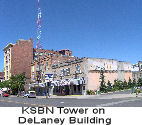KSBN's Tower on top of the Delaney Building.
HISTORICAL BACKGROUND
KREM, before its move to Moran Prairie, was the first station to occupy this very unique transmitter facility. To find out how this facility is unique, please continue to read the article below.
ED ANTOSYN COMMENTS
Ed Antosyn, in correspondence to Carl Partlow in about 1980, described the facility. Mr. Antosyn was a long time radio engineer who worked on many Spokane transmitter plants in Spokane, including this one.
"In the forties, KREM was built in the Realty Building on Riverside Avenue by Cole Wiley and a Canadian Radio Engineer, Les Burton. It was later acquired by Louis Wasmer. The antenna system comprised of a self-supporting vertical tower set on insulators on the roof of the Realty Building and an extensive counterpoise system of wires extended from the base of the tower and over the roof of the building to the cornices of the roof edges of the buildings on the surrounding streets and avenues, Main to Riverside and Bernard to Browne.
"This tower was dismantled in 1951 when KREM moved to Moran Prairie, at the directional site of KGA across the street from (the) KHQ-KGA transmitter building... (When KSPO moved from the Ziegler Building to the Realty Building, the tower had to be re-erected and the antenna tuned to the KSPO frequency.)"
HENRY B. POOLE'S EXCERPT FROM QSL LETTER
Henry B. Poole, chief technician at KREM in 1947, in a verification letter to Eugene Allen, also described the facility.
"... we have been received very well by the community and are enjoying considerably better coverage than could be reasonably be expected of a 250-watt station. Our equipment is General Electric, our antenna is a 190-foot tower atop a downtown building with approximately 45,000 feet of copper wire strung out for counterpoise."
SUMMARY
Some of the counterpoise system has been dismantled because of local construction, but much of it still remains. (See the photos below.)
Newspaper articles of the time revealed that the Realty building tower, which was erected in 1946, was razed in 1951. After receiving permission from the Spokane City Council, the new owners of KSPO, Del Cody and D. Gene Williams, re-erected a new tower in January and February 1952, and resumed broadcasting from the Realty Building on 24 February 1952 on 1230 kHz. KSPO changed frequency to 1340 on 10 January 1953 "due to noise." Later, the station changed frequency back to 1230 kHz, the current frequency of KSBN which is now transmitting from this site.
My June 2005 Visit to the Site
This is another site that I have driven by countless times for many, many years and never really paid much attention to. But in June 2005, I decided to take a closer look. I discovered what I had been missing because I had not paid attention to this very unique transmitting facility, when I took the pictures shown here below. From what I gather, this is a unique AM radio transmitting facility in that it transmits from the top of a building. Building top facilities were not unusual from the 1920's to the 1950's, but now most of them have been taken down and very few still exist. Angela Watkins, the General Manager at KSBN, in an email to the author said she has been told that the transmitter system employed by KSBN is one of two in the USA. I wonder which station is the other one. I was unable to get a tour of the roof top facility. That would have to wait for another time.
August 2008 Tour of the Roof Top Transmitter and Tower
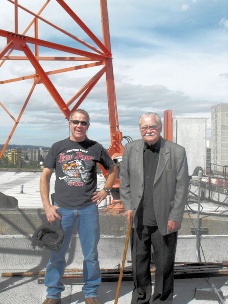
This time I was honored to be given a guided tour of the facility by Conrad Agte, owner of Vector Broadcasting and the current chief engineer of the station and Ed Antosyn, chief engineer of the station from the early 1950's. It was fun listening to the two of them talk about the station. At one point, Ed noticed that some equipment that he had installed was still on the wall of the transmitter shack. In response, Conrad replied, tongue-in-cheek, he left it there in honor of Ed. Ed later told me that he was glad the station is in good hands.
Conrad proudly showed us how he had re-done the cables to which the counterpoises wires are connected. He replaced the original copper braiding with copper wire to which he connected the counterpoise wires using a process of welding with cadmium.
Thanks to both Ed and Conrad for showing me around.
Conrad Agte can be contacted through his web page at Vector Broadcasting
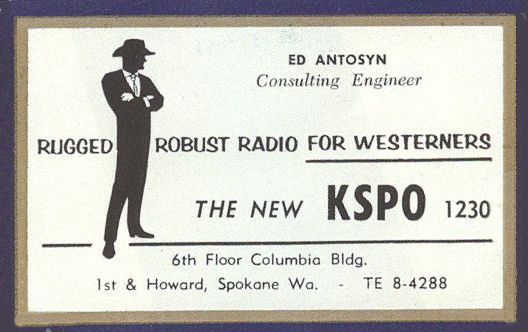
Photo Gallery of the Tower
Click on the thumbnails below for a larger view.
 April 1966. (Used by permission of Bill
Glenn).
April 1966. (Used by permission of Bill
Glenn).
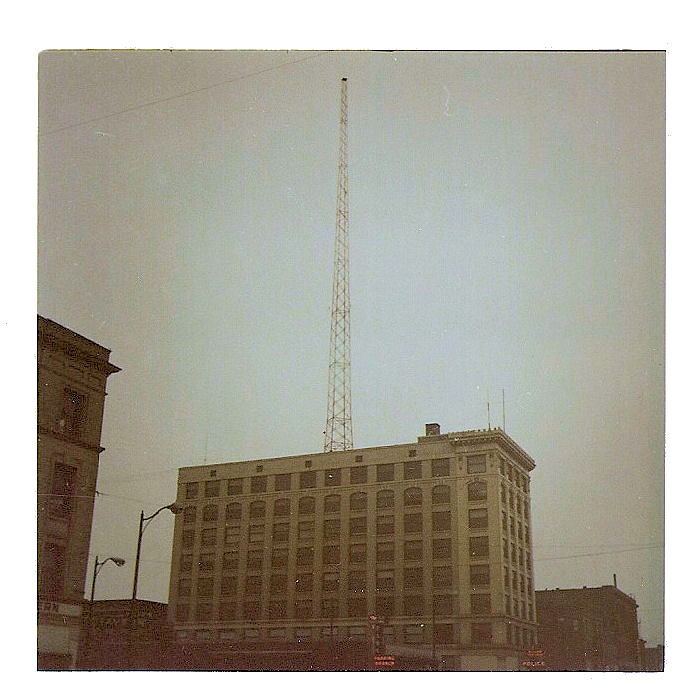 April 1966. (Used by permission of Bill
Glenn).
April 1966. (Used by permission of Bill
Glenn).
FULL VIEW OF DELANEY BUILDING
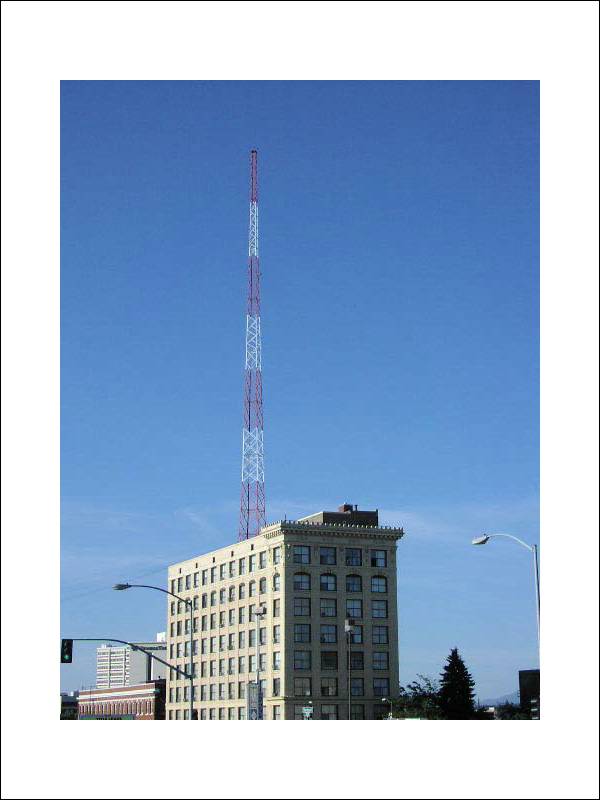
A full view of the Delaney Building with KSBN's tower on
top. Counterpoise wires are clearly visible on the left side of
the photo, just above the traffic light and the street
light.
(© philcobill.com)
COUNTERPOISE RADIALS ATTACHED TO ADJACENT BUILDINGS
 The counterpoise radial wires are attached to
anchor lines which are in turn attached to posts anchored to the
buildings. A post for the anchor line can be seen
at the upper right corner of the taller building, which
is at 230 W. Riverside. Counterpoise radial wires can be
seen running above the building from the upper left to the anchor
line post. (See "
A" in the radial sketch below.)
The counterpoise radial wires are attached to
anchor lines which are in turn attached to posts anchored to the
buildings. A post for the anchor line can be seen
at the upper right corner of the taller building, which
is at 230 W. Riverside. Counterpoise radial wires can be
seen running above the building from the upper left to the anchor
line post. (See "
A" in the radial sketch below.)
(© philcobill.com)
ANCHOR POINTS AND WIRE ALONG EDGE OF BUILDING
 In this picture, you can see the anchor posts
and anchor wire along the edge of the building at 230 West
Riverside Avenue and on the Delaney Building itself to which the
radial wires are attached. (See "
B" in the radial sketch below for greater detail of the
location.)
In this picture, you can see the anchor posts
and anchor wire along the edge of the building at 230 West
Riverside Avenue and on the Delaney Building itself to which the
radial wires are attached. (See "
B" in the radial sketch below for greater detail of the
location.)
(© philcobill.com)
VIEW FROM MAIN AVENUE AND BERNARD STREET
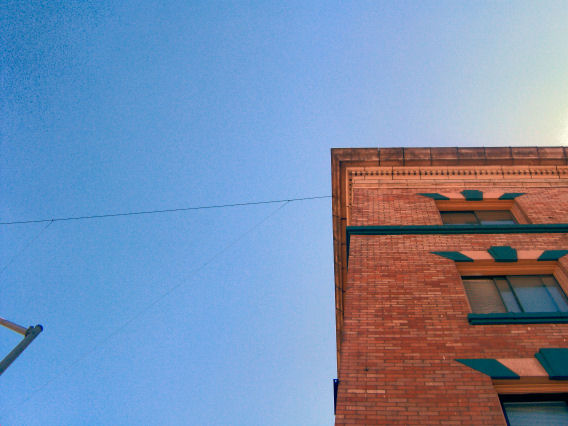 Looking at the corner of the building at the
southwest corner of Main Avenue and Bernard Street. You can see
where the anchor line is attached to the building and then going
off to the east (right to left). The counterpoise radial wires
are visible in the lower right part of the photo. (See "
C" in the radial sketch below.)
Looking at the corner of the building at the
southwest corner of Main Avenue and Bernard Street. You can see
where the anchor line is attached to the building and then going
off to the east (right to left). The counterpoise radial wires
are visible in the lower right part of the photo. (See "
C" in the radial sketch below.)
(© philcobill.com)
OTHER END OF ANCHOR LINE
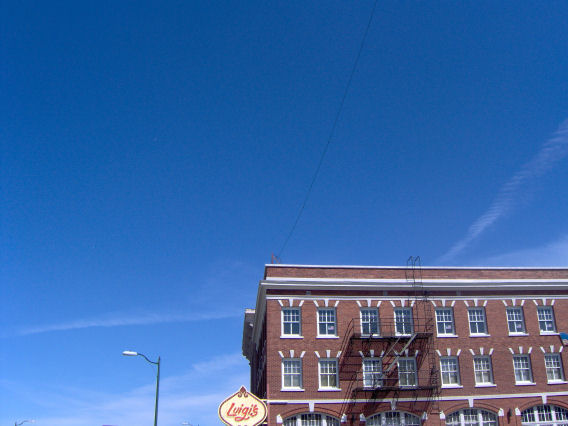 The other end of the above anchor line attached
to the building at 245 West Main. Again the counterpoise lines
are clearly visible. The counterpoise lines continue behind the
anchor point across the top of the building. (See "
D" in the radial sketch below.)
The other end of the above anchor line attached
to the building at 245 West Main. Again the counterpoise lines
are clearly visible. The counterpoise lines continue behind the
anchor point across the top of the building. (See "
D" in the radial sketch below.)
(© philcobill.com)
SKYWARD VIEW OF COUNTERPOISE WIRES
 Looking straight up at the southeast corner of
Main Avenue and Bernard Street. This location is between the
anchor points in the above two pictures. Up is West, Down is
East, Left is North, and Right is South. You can see the anchor
line running East and West, with the counterpoise radial wires on
the right-hand side of the picture running in a general Southeast
direction towards the Delaney Building. (See "
E" in the radial sketch below.)
Looking straight up at the southeast corner of
Main Avenue and Bernard Street. This location is between the
anchor points in the above two pictures. Up is West, Down is
East, Left is North, and Right is South. You can see the anchor
line running East and West, with the counterpoise radial wires on
the right-hand side of the picture running in a general Southeast
direction towards the Delaney Building. (See "
E" in the radial sketch below.)
(© philcobill.com)
DELANEY BUILDING FROM ACROSS THE STREET
View of the tower on top of the Delaney Building across the
street on Riverside, looking to the Northeast. See "
F" in the radial sketch below.) Ignore the ugly
dude.
(© philcobill.com)
BOTTOM STORIES OF DELANEY BUILDING
 Bottom stories of the Delaney Building from
across the street on Riverside. The building now contains
apartments for senior citizens. (See "
G" in the radial sketch below.)
Bottom stories of the Delaney Building from
across the street on Riverside. The building now contains
apartments for senior citizens. (See "
G" in the radial sketch below.)
(© philcobill.com)
ANOTHER FULL VIEW OF DELANEY BUILDING
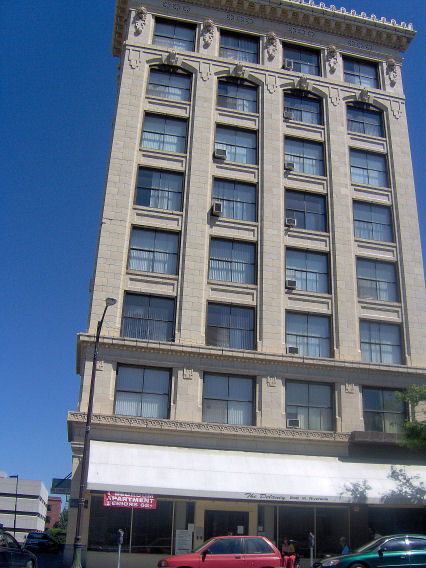 A full view of the Delaney Building. On the
left side of the picture, you can see counterpoise radial wires
going from the tower on top of the building to the West. (See
"
G" in the radial sketch below.)
A full view of the Delaney Building. On the
left side of the picture, you can see counterpoise radial wires
going from the tower on top of the building to the West. (See
"
G" in the radial sketch below.)
(© philcobill.com)
SATELLITE VIEW OF DELANEY BUILDING AND SURROUNDING AREA
 Satellite view of the Delaney Building and the
surrounding area. The pink cross on top of the building in the
middle is the base of the tower. The fuzzy pink line at about
100º is the tower and a shadow from the tower is visible in
the opposite direction. Compare with the sketch below.
Satellite view of the Delaney Building and the
surrounding area. The pink cross on top of the building in the
middle is the base of the tower. The fuzzy pink line at about
100º is the tower and a shadow from the tower is visible in
the opposite direction. Compare with the sketch below.
(© philcobill.com)
SURVEY SKETCH OF RADIALS RELATIVE TO BUILDINGS
 This is a sketch showing the relative locations of the
tower, the buildings, and the counterpoise radials. The circled
letters are references to photo locations as noted above. I ran
out of time to take a complete survey of the site so the part
showing the counterpoise radials is incomplete.
This is a sketch showing the relative locations of the
tower, the buildings, and the counterpoise radials. The circled
letters are references to photo locations as noted above. I ran
out of time to take a complete survey of the site so the part
showing the counterpoise radials is incomplete.
(© philcobill.com)


 (©
philcobill.com)
(©
philcobill.com) (©
philcobill.com)
(©
philcobill.com) (©
philcobill.com)
(©
philcobill.com) (©
philcobill.com)
(©
philcobill.com) (© philcobill.com)
(© philcobill.com) (©
philcobill.com)
(©
philcobill.com) (©
philcobill.com)
(©
philcobill.com) (©
philcobill.com)
(©
philcobill.com) (©
philcobill.com)
(©
philcobill.com) (© philcobill.com)
(© philcobill.com) (©
philcobill.com)
(©
philcobill.com) (© philcobill.com)
(© philcobill.com) (©
philcobill.com)
(©
philcobill.com) (©
philcobill.com)
(©
philcobill.com) (©
philcobill.com)
(©
philcobill.com) (© philcobill.com)
(© philcobill.com)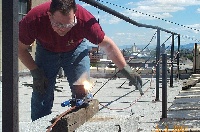 (Courtesy of Vector
Broadcasting)
(Courtesy of Vector
Broadcasting)
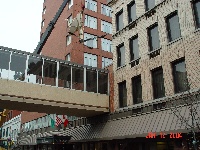 (Courtesy of
Vector Broadcasting)
(Courtesy of
Vector Broadcasting)
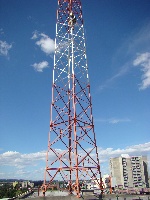 (Courtesy of Vector Broadcasting)
(Courtesy of Vector Broadcasting)
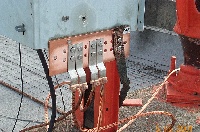 (Courtesy of
Vector Broadcasting)
(Courtesy of
Vector Broadcasting)
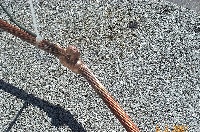 (Courtesy of Vector
Broadcasting)
(Courtesy of Vector
Broadcasting)
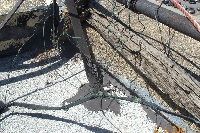 (Courtesy of Vector
Broadcasting)
(Courtesy of Vector
Broadcasting)
SOURCES:
- Agte, Conrad. Conversation during tour of transmitting facility. Spokane, Washington. 28 August 2008.
- Antosyn, Edward. "Radio Station KREM." Letter to Carl Partlow for the Early Days of Spokane Radio manuscript. Spokane, Washington. About 1980.
- Antosyn, Edward. Various interviews and conversations July and August 2008.
- CDBS Database. fcc.gov. Last accessed 19 May 2007.
- "Council Approves Tower Re-erection." Spokane Daily Chronicle, Page 3, Spokane, Washington. 30 January 1952.
- FCC License Records. various. ---NEED TO SPECIFY----
- "Council Asked to Okay Tower O.K." Spokesman Review, Page 6, Spokane, Washington. 22 January 1952.
- "KSPO Abandons Former Frequency Due to Noise." Spokesman Review, Page 7. Spokane, Washington. 10 Jan 1953.
- "KSPO's Buyers Await FCC Nod." Spokesman-Review, page 5. Spokane, Washington. 21 December 1951.
- Poole, Henry B. QSL verification letter to Gene Allen of Vallejo, California. Spokane, Washington. 17 January 1947.
- "Radio KSPO Gets New Frequency." Spokane Daily Chronicle, Page 5. Spokane, Washington. 6 January 1953.
- "Radio Station Here Gets O.K. on Change." Spokane Daily Chronicle, Page 23. Spokane, Washington. 2 October 1952.
- "Radio Tower Allowed On Top of Building." Spokesman Review, Page 6. Spokane, Washington. 31 January 1952.
- "Station seeks Tower Permit." Spokane Daily Chronicle, Page 5, Spokane, Washington. 21 January 1952.
- Watkins, Angela, General Manager of KSBN. Email to Bill Harms. 15 May 2007.
by Bill Harms - Updated 6 September 2008
KREM 1340 7 March 1947
KSPO 1340 9 Jun 1950
KLYK 1230 17 June 1957
KSPO 1230 22 September 1964
KKER 1230 15 August 1983
KRSS 1230 5 August 1985
KSBN 1230 29 April 1991
Downtown Spokane
Delaney Building, 242 West Riverside Avenue
FRN - 64668


